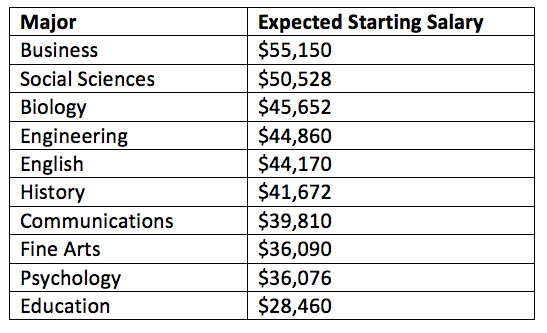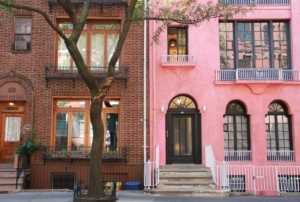As new college graduates across the country trade in their backpacks for briefcases, many will go where employment opportunities are ripe. But in a cruel irony, the areas with the greatest allure and abundance of jobs often have the highest living costs, adding another set of challenges for recent graduates. As one of the top destinations for graduates looking to start their careers after college, and being one of the most expensive places to live in the world, New York City fits this mold all too well.
In budgeting housing costs, the standard rule of thumb is to keep costs at or below 30 percent of total income in order to remain “affordable.” As any New Yorker will tell you, however, renting in New York City is not cheap. According to recent StreetEasy estimates, the typical New York household will spend nearly 60 percent of its income on rent and the median asking rent in NYC is expected to reach nearly $2,700 in 2015. For recent college graduates who have relatively lower entry-level incomes, the city’s rental landscape is even less affordable.
So, where can NYC-bound grads afford to live? Using starting income estimates for common occupations pursued by college graduates of various disciplines, we calculated the maximum possible rent that a recent grad could afford while still putting money towards student loan repayment, taxes, and the hefty living expenses in New York City. We also factored in how one or two roommates would affect possible rental options for each major. Our findings suggest that to afford rent in New York, recent college grads will likely need to move into areas far removed from Manhattan and double up – or even triple up – on roommates.
To improve affordability, get out of Manhattan
High rent and constricted supply of rental units make Manhattan a particularly challenging rental market for recent grads. Across all majors and their corresponding starting salary, the rental market is far more affordable in parts of Northern Queens, South Bronx, and East Brooklyn. A few neighborhoods in particular jump out as grad-friendly, including: Crown Heights (Brooklyn), Astoria (Queens), Bedford-Stuyvesant (Brooklyn) and Bushwick (Brooklyn). In each of these markets, rental inventory is high and asking rents are low relative to the rest of the city.
[tableau server=”public.tableau.com” workbook=”collegeRentAffordability_v1″ view=”RentAffordabilityPane” tabs=”no” toolbar=”” revert=”” refresh=”” linktarget=”” width=”600px” height=”600px”]

Not all parts of Manhattan need to be avoided, however. Plenty of affordable rental units are available in Upper Manhattan (north of 110th Street), particularly in the Washington Heights, East Harlem, and Central Harlem markets.
To see what neighborhoods have the greatest amount of affordable units for your particular major, desired rent-to-income ratio and number of roommates, use our interactive map above.
Doubling – and tripling – up to save money
Affordability is greatly improved across all majors when more roommates are brought into the picture. If you were a social sciences major, for example, by living with two other roommates you can keep your rent-to-income ratio at 30 percent and still be able to afford roughly 60 percent of the city’s 3-bedroom rental listings. If you were to live alone, however, only 2.7 percent of the city’s studio and 1 bedroom listings would be within your budget.
[tableau server=”public.tableausoftware.com” workbook=”collegeRentAffordability_v1″ view=”InventorySharePane” tabs=”no” toolbar=”” revert=”” refresh=”” linktarget=”” width=”600px” height=”600px”]
If grads prefer living alone, it is highly likely that they will need to spend more than 30 percent of their income on rent. Just 5.1 percent of all studio and 1-bedroom rental listings in New York City in 2014 were affordable to business majors – and no studio and 1-bedroom listings were affordable to education majors!
The graph above shows the percentage of rentals that were available to each major by number of roommates and assumed monthly rent-to-income ratio. Spending just 30 percent of income on rent is nearly impossible for recent grads living alone. Even with a rent-to-income ratio of 50 percent, only a tiny share (1.4 percent) of all studio and one bedroom rental listings are affordable to education majors.
Who is moving to New York City?
As the home of Wall Street and the bright lights of Broadway, it’s no surprise that New York receives more than its fair share of business and fine arts majors. Approximately 21 percent of U.S. graduates received a business degree between 2010 and 2013, but they accounted for nearly 24 percent of graduates that move to New York[i]. Nationally, 6 percent of graduates majored in fine arts, but that ratio is doubled in New York at approximately 12 percent[ii].
When it comes to expected median income for these New York City-bound college grads, business majors come out on top. According to Occupational Employment Statistics (OES) survey data, the median starting income for business majors was $55,150 in 2014. At the lowest end of the spectrum are education majors, who are expected to earn a median starting income of $28,460, almost half of what business majors can expect to earn.
How did we do it?
We used 2010 to 2013 IPUMS ACS 1-year data[iii] for educational information on migrants aged between 22 and 25 years old who moved into New York City from outside its limits less than 1 year prior to the ACS survey. Expected salaries are derived from Occupational Employment Statistics (OES) survey data using standard occupational classifications. Incomes are matched to the IPUMS migrant sample by reasonably inferring the common occupations pursued by different educational disciplines. For each major (and corresponding median salary of occupations associated with each major), we calculated monthly rent levels associated with 30, 40, and 50 percent of income and the number of rental listings on StreetEasy throughout 2014 that met such rent levels for every neighborhood with sufficient data. For zero roommates, we limited inventory to just studio and 1-bedroom listings; for one roommate, we limited inventory to just 2-bedroom listings; and for two roommates, we limited inventory to 3-bedroom listings.
[i] 1-year ACS data
[ii] Ibid.
[iii] IPUMS-USA, University of Minnesota, www.ipums.org.








